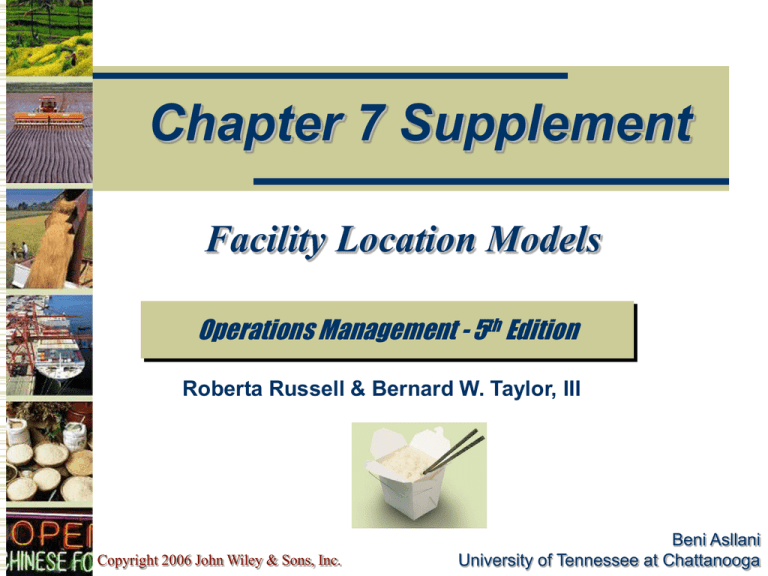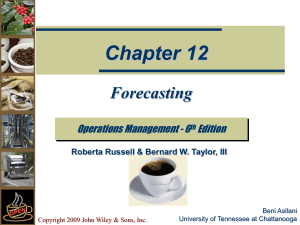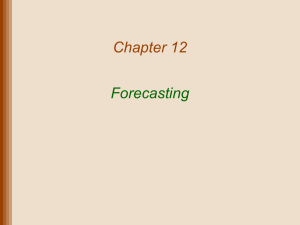
Chapter 7 Supplement
Facility Location Models
Operations Management - 5th Edition
Roberta Russell & Bernard W. Taylor, III
Copyright 2006 John Wiley & Sons, Inc.
Beni Asllani
University of Tennessee at Chattanooga
Lecture Outline
Types of Facilities
Site Selection: Where to Locate
Location Analysis Techniques
Copyright 2006 John Wiley & Sons, Inc.
Supplement 7-2
Types of Facilities
Heavy-manufacturing facilities
large, require a lot of space, and are
expensive
Light-industry facilities
smaller, cleaner plants and usually less
costly
Retail and service facilities
smallest and least costly
Copyright 2006 John Wiley & Sons, Inc.
Supplement 7-3
Factors in Heavy Manufacturing
Location
Construction costs
Land costs
Raw material and finished goods
shipment modes
Proximity to raw materials
Utilities
Labor availability
Copyright 2006 John Wiley & Sons, Inc.
Supplement 7-4
Factors in Light Industry
Location
Transportation costs
Proximity to markets
Frequency of delivery required by
customer
Land costs
Easily accessible geographic region
Education and training capabilities
Copyright 2006 John Wiley & Sons, Inc.
Supplement 7-5
Factors in Retail Location
Proximity to customers
Location is everything
Copyright 2006 John Wiley & Sons, Inc.
Supplement 7-6
Global Location Factors
Government stability
Government regulations
Political and economic
systems
Economic stability and growth
Exchange rates
Culture
Climate
Export import regulations,
duties and tariffs
Copyright 2006 John Wiley & Sons, Inc.
Raw material availability
Number and proximity of
suppliers
Transportation and
distribution system
Labor cost and education
Available technology
Commercial travel
Technical expertise
Cross-border trade
regulations
Group trade agreements
Supplement 7-7
Regional Location
Factors
Labor (availability,
education, cost, and
unions)
Proximity of customers
Number of customers
Construction/leasing
costs
Land cost
Copyright 2006 John Wiley & Sons, Inc.
Modes and quality of
transportation
Transportation costs
Community government
Local business
regulations
Government services
(e.g., Chamber of
Commerce)
Supplement 7-8
Regional Location Factors
(cont.)
Business climate
Community services
Incentive packages
Government regulations
Environmental
regulations
Raw material availability
Commercial travel
Climate
Copyright 2006 John Wiley & Sons, Inc.
Infrastructure (e.g.,
roads, water, sewers)
Quality of life
Taxes
Availability of sites
Financial services
Community inducements
Proximity of suppliers
Education system
Supplement 7-9
Location Incentives
Tax credits
Relaxed government regulation
Job training
Infrastructure improvement
Money
Copyright 2006 John Wiley & Sons, Inc.
Supplement 7-10
Location Analysis Techniques
Location rating factor
Center-of-gravity
Load-distance
Copyright 2006 John Wiley & Sons, Inc.
Supplement 7-11
Location Rating Factor
Identify important factors
Weight factors (0.00 - 1.00)
Subjectively score each factor (0 - 100)
Sum weighted scores
Copyright 2006 John Wiley & Sons, Inc.
Supplement 7-12
Location Factor Rating: Example
SCORES (0 TO 100)
LOCATION FACTOR
Labor pool and climate
Proximity to suppliers
Wage rates
Community environment
Proximity to customers
Shipping modes
Air service
WEIGHT
Site 1
Site 2
Site 3
.30
.20
.15
.15
.10
.05
.05
80
100
60
75
65
85
50
65
91
95
80
90
92
65
90
75
72
80
95
65
90
Weighted Score for “Labor pool and climate” for
Site 1 = (0.30)(80) = 24
Copyright 2006 John Wiley & Sons, Inc.
Supplement 7-13
Location Factor Rating
WEIGHTED SCORES
Site 1
Site 2
Site 3
24.00
20.00
9.00
11.25
6.50
4.25
2.50
77.50
19.50
18.20
14.25
12.00
9.00
4.60
3.25
80.80
27.00
15.00
10.80
12.00
9.50
3.25
4.50
82.05
Copyright 2006 John Wiley & Sons, Inc.
Site 3 has the
highest factor rating
Supplement 7-14
Factor
Rating
with
Excel
Copyright 2006 John Wiley & Sons, Inc.
Supplement 7-15
Center-of-Gravity
Technique
Locate facility at center of
geographic area
Based on weight and distance
traveled establish grid-map of
area
Identify coordinates and
weights shipped for each
location
Copyright 2006 John Wiley & Sons, Inc.
Supplement 7-16
Grid-Map Coordinates
y
n
x=
i=1
1 (x1, y1), W1
3 (x3, y3), W3
y3
x1
x2
x3
Copyright 2006 John Wiley & Sons, Inc.
yiWi
i=1
y=
n
y1
xiWi
i=1
2 (x2, y2), W2
y2
n
Wi
n
Wi
i=1
where,
x, y = coordinates of new facility
at center of gravity
xi, yi = coordinates of existing
facility i
Wi = annual weight shipped from
facility i
x
Supplement 7-17
Center-of-Gravity Technique:
Example
y
x
y
Wt
700
C
600
Miles
500
(135)
B
200
B
100
500
105
C
250
600
135
D
500
300
60
(105)
400
300
A
200
200
75
D
(60)
A
(75)
100
0
100 200 300 400 500 600 700 x
Miles
Copyright 2006 John Wiley & Sons, Inc.
Supplement 7-18
Center-of-Gravity Technique:
Example (cont.)
n
xiWi
x=
i=1
n
Wi
(200)(75) + (100)(105) + (250)(135) + (500)(60)
=
= 238
75 + 105 + 135 + 60
i=1
n
y=
yiWi
i=1
n
Wi
(200)(75) + (500)(105) + (600)(135) + (300)(60)
=
= 444
75 + 105 + 135 + 60
i=1
Copyright 2006 John Wiley & Sons, Inc.
Supplement 7-19
Center-of-Gravity Technique:
Example (cont.)
y
700
C
600
Miles
500
(135)
B
(105)
400
300
200
A
x
y
Wt
A
200
200
75
B
100
500
105
C
250
600
135
D
500
300
60
Center of gravity (238, 444)
D
(60)
(75)
100
0
100 200 300 400 500 600 700 x
Miles
Copyright 2006 John Wiley & Sons, Inc.
Supplement 7-20
Center
of
Gravity
with
Excel
Copyright 2006 John Wiley & Sons, Inc.
Supplement 7-21
Load-Distance Technique
Compute (Load x Distance) for each site
Choose site with lowest (Load x Distance)
Distance can be actual or straight-line
Copyright 2006 John Wiley & Sons, Inc.
Supplement 7-22
Load-Distance Calculations
n
ld
LD =
i
i
i=1
where,
LD =
load-distance value
li
load expressed as a weight, number of trips or units
being shipped from proposed site and location i
=
di
=
distance between proposed site and location i
di
=
(xi - x)2 + (yi - y)2
where,
(x,y) = coordinates of proposed site
(xi , yi) = coordinates of existing facility
Copyright 2006 John Wiley & Sons, Inc.
Supplement 7-23
Load-Distance: Example
Potential Sites
Site
X
1
360
2
420
3
250
Y
180
450
400
A
200
200
75
X
Y
Wt
Suppliers
B
C
100
250
500
600
105
135
D
500
300
60
Compute distance from each site to each supplier
Site 1 dA =
dB =
=
(200-360)2 + (200-180)2 = 161.2
(xB - x1)2 + (yB - y1)2 =
(100-360)2 + (500-180)2 = 412.3
(xA - x1)2 + (yA - y1)2
dC = 434.2
Copyright 2006 John Wiley & Sons, Inc.
dD = 184.4
Supplement 7-24
Load-Distance: Example (cont.)
Site 2 dA = 333
dB = 323.9 dC = 226.7 dD = 170
Site 3 dA = 206.2 dB = 180.4 dC = 200
dD = 269.3
Compute load-distance
n
LD =
ld
i
i
i=1
Site 1 = (75)(161.2) + (105)(412.3) + (135)(434.2) + (60)(434.4) = 125,063
Site 2 = (75)(333) + (105)(323.9) + (135)(226.7) + (60)(170) = 99,791
Site 3 = (75)(206.2) + (105)(180.3) + (135)(200) + (60)(269.3) = 77,555*
* Choose site 3
Copyright 2006 John Wiley & Sons, Inc.
Supplement 7-25
LoadDistance
with
Excel
Copyright 2006 John Wiley & Sons, Inc.
Supplement 7-26
Copyright 2006 John Wiley & Sons, Inc.
All rights reserved. Reproduction or translation of this work beyond that
permitted in section 117 of the 1976 United States Copyright Act without
express permission of the copyright owner is unlawful. Request for further
information should be addressed to the Permission Department, John Wiley &
Sons, Inc. The purchaser may make back-up copies for his/her own use only and
not for distribution or resale. The Publisher assumes no responsibility for
errors, omissions, or damages caused by the use of these programs or from the
use of the information herein.
Copyright 2006 John Wiley & Sons, Inc.
Supplement 7-27


